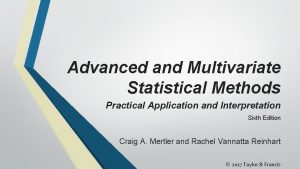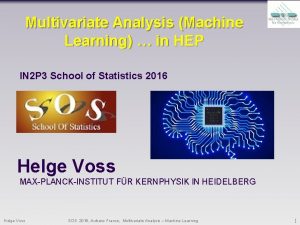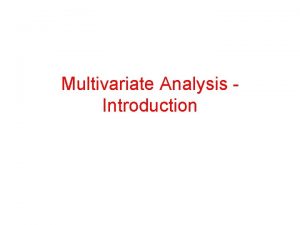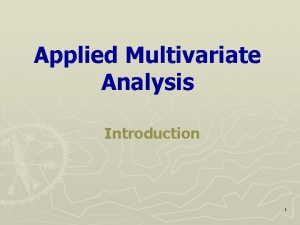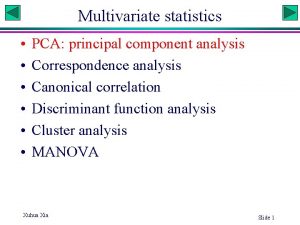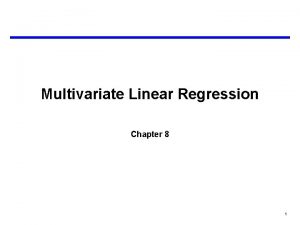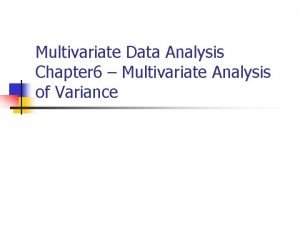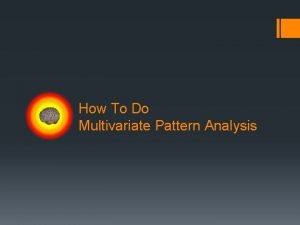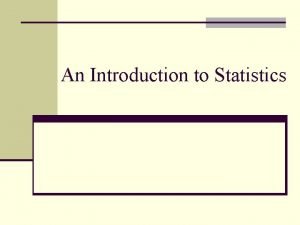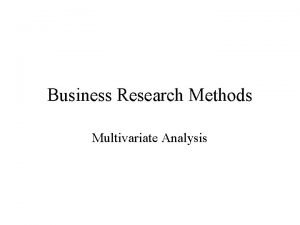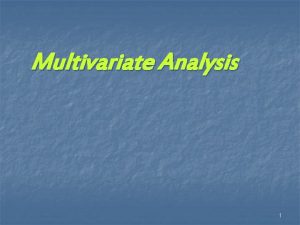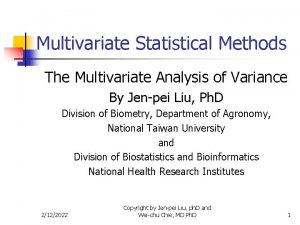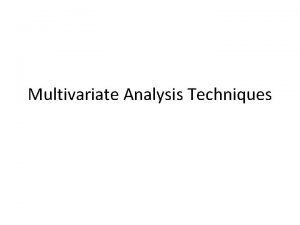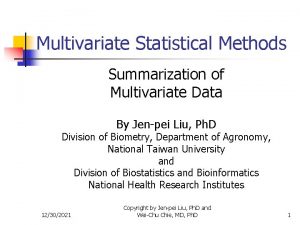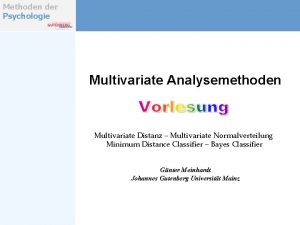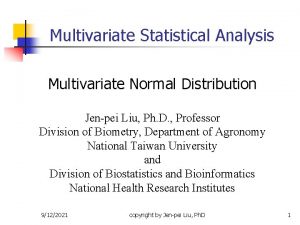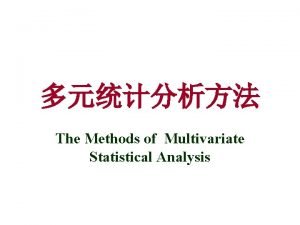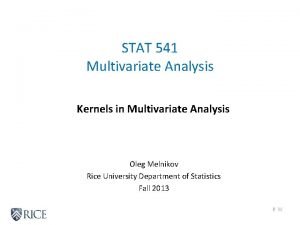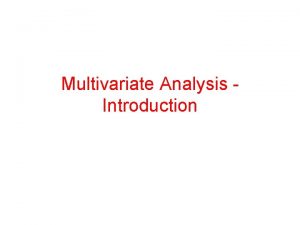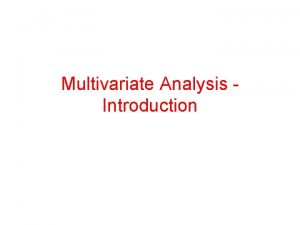Statistical Software SAMMIF Sensitivity Analysis in Multivariate Methods














- Slides: 14

Statistical Software “SAMMIF” Sensitivity Analysis in Multivariate Methods based on Influence Functions SAMMIF Project Yuichi MORI Yoshiro YAMAMOTO Shingo WATADANI Yoshimasa ODAKA Tomoyuki TARUMI Yutaka TANAKA Okayama Univ. of Science Graduate School, Okayama Univ. Kurashiki Univ. of Science and the Arts Okayama Univ.

Outline of our presentation • About SAMMIF – Motivation and process of developments. – Ideas in SAMMIF. – General procedure and flow of “SAMMIF”. • Demonstration of “SAMMIF” – Exploratory factor analysis. • open/closed book data (Mardia et al, 1979) • Discussion and Future plans

Motivation for development • Sensitivity analysis procedures using influence functions and their analogues; • SAM(Tarumi and Tanaka, 1986), • SAF/B(Odaka, Watadani and Tanaka, 1991), • SAF/S(Inoue, Odaka and Tanaka, 1991), • SAM II(Mori and Tarumi, 1993), • SACS(Watadani and Tanaka, 1994), etc. – developed for a specified family of multivariate methods separately, – most of them run on MS-DOS (BASIC) platform. • Necessary to develop a new program; – unifying any multivariate method where influence functions or their analogues are available, – reinforcing GUI under the Windows environment.

Sensitivity analysis Influence of the i-th observation? Data the i-th obs. Multivariate method Data Results ^θ Multivariate method i= 1, . . . , n Results(i) θ^(i)

Empirical Influence Function • Introduce perturbation to the cdf F, , where is the cdf of a unit point mass at x. • Empirical Influence Function (EIF), .

Empirical Influence Function • Influence of k observations –approximation of , . Influence of one observation Influences of subsets, • influential individually, • similar influence patterns. Canonical Variate Analysis Cook’s Local Influence

Sensitivity analysis based on influence functions Data n obs. EIF Parameters Vectors, More than one Observable measures Influence of multiple obs. Summarizing them into scalar measures Applying CVA or PCA to EIF

Flow of SAMMIF Data entry Prior analysis Single-case diagnostics Multiple-case diagnostics Posterior analysis Comparison (Pre / Post) 1) Data 2) Pre Estimate ordinarily using all observations. 3) Diagnostics 3 -1) SD Compute EIFs and summarize them to influence measures. 3 -2) MD Apply CVA or PCA to EIFs. 4) Post Estimate without observations of interest. 5) Comp Compare results in 4) with in 2).

Flow of SAMMIF 1) Data 2) Pre Data entry measures Influence Estimate ordinarily using 1) Influence on the estimate ; all observations. Prior analysis (a) Euclidean norm, 3) Diagnostics (b) Generalized Cook's distance. 3 -1) SD Single-case diagnostics Compute EIFs and summarize 2) Influence on the precision; them to influence measures. 3 -2) MD (c) COVRATIO-like measure. Multiple-case diagnostics Apply CVA or PCA to EIFs. Post 3) Influence on the 4) goodness-of-fit; without Posterior (d) Changeanalysis of X 2, Estimate observations of interest. (e) Change of goodness-of-fit index (GFI), 5) Comparison (Pre / Post) (f) Change of root mean square residual (RMR). Compare results in 4) with in 2).

Features of SAMMIF (Version 0. 8) • Developing tool: MS-Visual Basic • Language: English / Japanese • Included method: Factor analysis – Sensitivity analysis in Exploratory FA – Sensitivity analysis in Confirmatory FA • Features (other than Windows functions): – Clicablemap-type flowchart, – Graphical displays, – Brief tutorial, Hint options, – Standard / detail outputs, – Intermediate reports, savable outputs.

Example (Demonstration) • Factor analysis –Basic model , f : common factor, e: unique factor, : mean vector : Factor loading matrix –Covariance matrix of x, Estimated parameters • Example –Method: Exploratory factor analysis –Data: “open/closed book data (Mardia et al, 1979)”, – 88 observations, 5 variables.

Demonstration of “SAMMIF” • Method: Exploratory factor analysis • Data: “open/closed book data (Mardia et al, 1979)” • 88 observations, 5 variables.

Discussion and Future plans • SAMMIF – provides important information easily, – for diagnostic checking of the data. • Future plans – Include other multivariate methods: • LISREL type covariance structure analysis, • PCA, • Canonical correlation analysis, etc. – Other type of perturbation scheme – Improve convenience: • • for both beginners and experts, various options, Interface with other software, enrichment of helps and consultation.

Distribution Exe files Brief tutorial file Sample data Manual (in HTML) English / Japanese Publication On the Web okayama-u. ac. jp ous. ac. jp kusa. ac. jp January, 1998 SAMMIF Sensitivity Analysis in Multivariate Methods based on Influence Functions Contact to Yuichi MORI Okayama University of Science Dept. Socio-Information mori@soci. ous. ac. jp
 Advanced and multivariate statistical methods
Advanced and multivariate statistical methods Multivariate statistical analysis
Multivariate statistical analysis Multivariate methods in machine learning
Multivariate methods in machine learning What is multivariate analysis
What is multivariate analysis Multiple variance analysis
Multiple variance analysis Nature of multivariate analysis
Nature of multivariate analysis Multivariate analysis of variance and covariance
Multivariate analysis of variance and covariance Multivariate analysis
Multivariate analysis Multivariate analysis
Multivariate analysis Multivariate analysis
Multivariate analysis Multivariate pattern analysis
Multivariate pattern analysis Conjoint analysis in r
Conjoint analysis in r Statistical methods of demand forecasting
Statistical methods of demand forecasting Statistical methods of demand forecasting
Statistical methods of demand forecasting Two branches of statistics are
Two branches of statistics are
